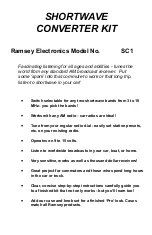
12. RATINGS PLATE
On the rear of the inverter is the ratings plate, giving the following data:
1 - Rating of internal protection provided by casing.
2 - symbol for power supply line: 1= single-phase AC.
3 -
S
: Indicates that welding may be carried out in environments with a
heightened risk of electric shock e.g. very close to large metallic objects.
4 - Welding procedure: manual arc welding with covered electrode
5 - symbol for internal structure of the welding machine.
6 - The eURoPeAN standard relating to the safety and construction
of arc welding machines.
. 7 - Manufacturers serial Number for welding machine identification.
8 - output
Uº: Maximum no load voltage.
I², U²: Current and corresponding normalised voltage that the
welding machine can supply during welding.
X: Welding ratio based on a 10 minute duty cycle. 30% indicates 3
minutes welding and 7 minutes rest, 100% indicates continuous welding.
A/V-A/V: shows the range of adjustment for the welding current
(minimum - maximum) at the corresponding arc voltage.
9 - Power supply
U
1
: Alternating voltage and power supply frequency of welding machine. (allowed limit ± 10%)
I
1
max
: Maximum current absorbed by the line.
I
1
eff
: effective current supplied.
10 - size of delayed fuse for protection of power supply.
11 - symbols referring to safety regulations.
13. ELECTROMAGNETIC COMPATIBILITY
13.1.
THIs eQUIPMeNT Is IN CoNFoRMITY WITH THe eURoPeAN sTANdARd oN THe eleCTRoMAGNeTIC CoMPATIBIlITY
oF ARC WeldING eQUIPMeNT ANd sIMIlAR PRoCesses (e.g. ARC ANd PlAsMA CUTTING)
13.2.
Protection against interference. (E.M.C.)
The emission limits in this standard may not, however, provide full protection against
interference to radio and television reception when the equipment is used closer than 30m to the receiving antenna. In special cases,
when highly susceptible apparatus is being used in close proximity, additional mitigation measures may have to be employed in order
to reduce the electromagnetic emissions. At the same time there could occur some potential difficulties in having electromagnetic
compatibility in a non-industrial environment (e.g. in residential areas). Therefore it is most important that the equipment is used and
installed according to the following instructions.
13.3.
Installation and use.
The user is responsible for installing and using the equipment according to these instructions. If electromagnetic
disturbances are detected, then it shall be the responsibility of the user of the equipment to resolve the situation with the technical
assistance of the supplier. In some cases this remedial action may be as simple as earthing the circuit (see Note). In other cases it
could involve constructing an electromagnetic screen, enclosing the welding power source and the work, with associated input filters. In
all cases the electromagnetic disturbances shall be reduced to the point where they are no longer troublesome.
Note:
The welding/cutting circuit may or may not be earthed for safety reasons. Changing the earthing arrangements should only be
authorised by a person who is competent to assess whether the changes will increase the risk of injury, e.g. by allowing parallel
welding/cutting circuit return paths which may damage the earth circuits of other equipment. Further guidance is given in IeC 974-13 ’Arc
Welding equipment - Installation and Use.’
13.4.
Assessment of area.
Before installing the equipment the user shall make an assessment of potential electromechanical problems in the
surrounding area. The size of the surrounding area to be considered will depend on the structure of the building and other activities that
are taking place. The surrounding area may extend beyond the boundaries of the premises.
The following shall be taken into account:
a) other supply cables, control cables, signalling and telephone cables, above, below and adjacent to the welding equipment.
b) Radio and television transmitters and receivers.
c) Computer and other control equipment.
d) safety critical equipment, e.g. security monitoring of industrial equipment.
e) The health of people in the vicinity, e.g. persons fitted with a pacemaker or hearing aid.
f) equipment used for calibration or measurement.
g) The immunity of other equipment in the environment. The user shall ensure that other equipment being used in the environment is
compatible. This may require additional protective measures.
h) The time of day that welding and other activities are to be carried out.
13.5.
Mains supply.
The equipment should be connected to the mains supply according to these instructions. If interference occurs, it may be
necessary to take additional precautions such as filtering of the mains supply. Consideration should also be given to shielding the supply
cable of permanently installed equipment in metallic conduit or equivalent. This shielding should be connected to the power source so
that good electrical contact is maintained between the conduit and the welding power source enclosure.
Original Language Version
11. TROUBLESHOOTING
If you have a problem with the inverter, check to ensure that the following are correct:
●
Check that the welding current, which is controlled by the potentiometer (fig.7), is suitable for the diameter and type of electrode being
used.
●
When the mains rocker switch is on, check that the green mains lamp is on. If this is not the case then there may be a mains supply
problem.
●
Check the yellow led - has the thermal cut-out activated? This indicates either an over or under voltage or short circuit. If the thermal
interrupter has activated, wait for the machine to cool down before re-starting.
●
Check the nominal interruptance ratio is correct, and check that the fan is working correctly.
●
ensure that you are using the correct supply voltage.
●
Check the machine output and ensure there is nothing causing a short-circuit.
●
Check that all circuit connections are correct. In particular check that the work clamp is correctly attached to the workpiece. ensure that
there is no grease, paint etc. on the surface.
MW131, MW151, MW151PlUs Issue No.1 24/10/11

























